1969 United States Grand Prix race report: Rindt runs the show
Jochen Rindt converts his 6th pole of the season into a debut win; Piers Courage finishes 2nd for Williams
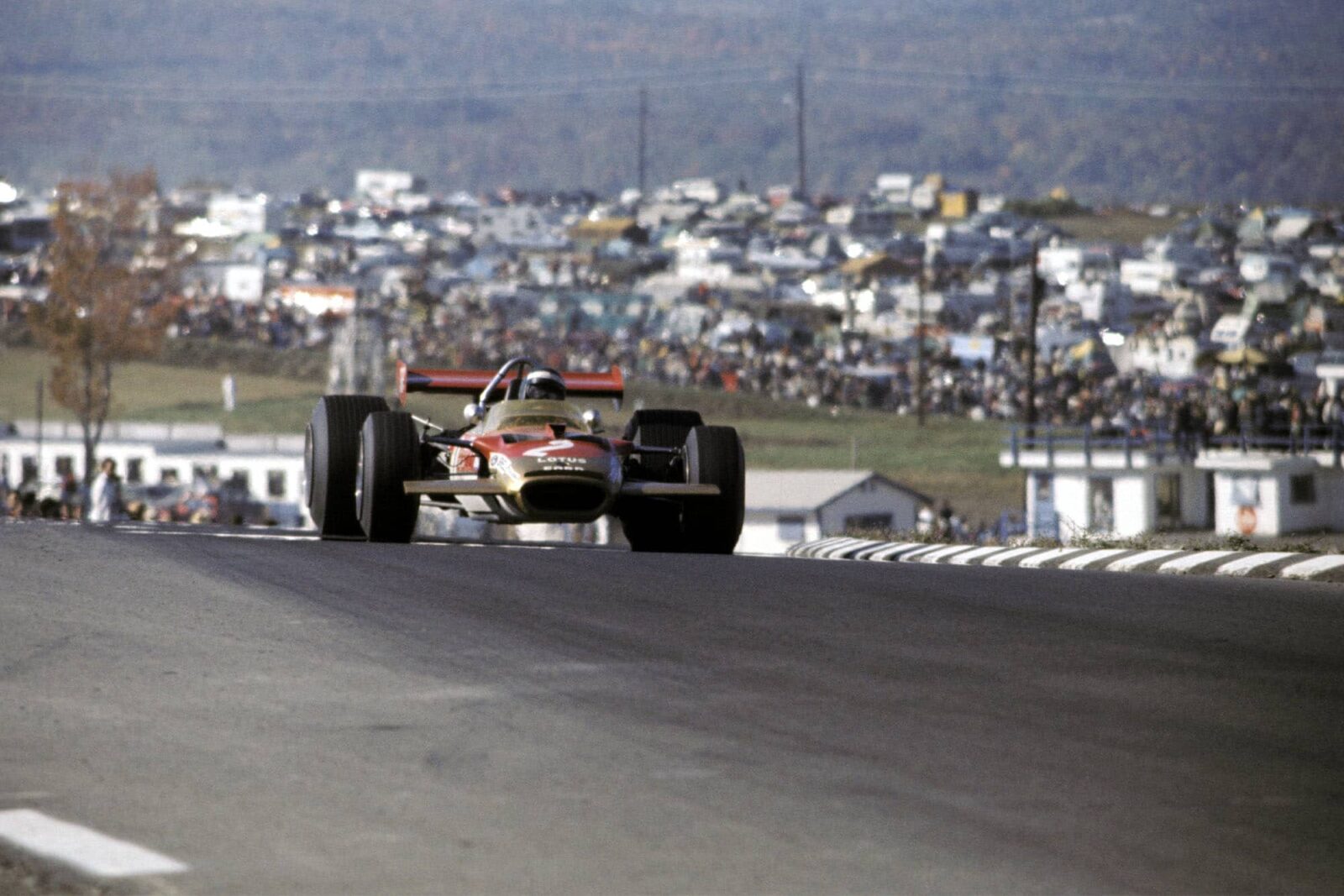
Rindt took his debut F1 win driving for Lotus at the United States Grand Prix
Motorsport Images
The 1969 World Championship had been settled while the Grand Prix cars were still in Europe, but to some minds there was even more at stake at Watkins Glen. The circuit, which is run on a non-profitmaking basis, attracts a huge crowd and after last year’s race there was a large surplus in the kitty. Some of this went to local charities, some to improving the circuit, but a considerable amount to providing the largest sum of prize money ever offered for a Formula One race. The purse, as the Americans like to call this, was no less than $200,000, with the first place driver taking a quarter of this figure. Money like this talks and many of the teams were putting on a special effort at Watkins Glen, but even if a competitor failed to complete one lap he went away with nearly £2,700.
Watkins Glen is a sleepy little town of 3,000 inhabitants in the northern part of New York State not very far from the Canadian border. It is well placed for drawing large crowds, and by race day over 100,000 had passed through the turnstiles. Many of them like to make a weekend of the racing, which is not surprising considering the vast distances which some of the spectators travel, while the huge camping sites get packed to capacity. However, the organisers resisted the temptation to run supporting events and kept the side attractions to a drivers’ seminar and a demonstration of parachuting.
The track itself is rather short for a Grand Prix, being only 2.3 miles round over hilly countryside. It has several fast corners and one right-angled bend just before the pits, and average speeds are high, being in the region of 126mph.
As the cars had all with one exception come straight from the Canadian Grand Prix, and thus not returned to their respective factories, they were very much in the same trim as at the previous race. The distance between Mosport Park and Watkins Glen could be easily covered by road in a day, so the teams had plenty of time to work on the cars in the extensive building laid on for this purpose at the Watkins Glen circuit.
Since Canada’s race there had been considerable air traffic between America and England, with a shuttle-service to Northampton, the home of Cosworth Engineering, so that many of the teams had freshly built engines. These engines were installed in the chassis while many of the cars were completely taken apart and rebuilt.
Number 1 on the programme was allocated to reigning World Champion Hill, and No 2 to Rindt, but the third Lotus, the 4wd car of Andretti, was No 9. Both Hill and Rindt were in their usual 49Bs, the same two cars they have run from the Dutch GP onwards, although Hill did use another car for Silverstone. The 63 was the car driven by Miles at Mosport Park, Canada and by Andretti at the Nurburgring (when he crashed). Andretti was at the wheel again and great things were expected from him as he had rocked the Grand Prix world at this race last year by setting fastest practice lap.
The Matra International team were also three strong again with Stewart and Beltoise in their usual Matra MS80s and Servoz-Gavin in the MS84 four-wheel-drive car for the second time this season. In addition a brand new MS80 monocoque had been flown in from Paris just in case one of the cars was damaged. One could not help admiring the beautiful precision finish on this “tub”, yet after the Mexican Grand Prix it will be completely obsolete and unusable as a Formula One car because of the new bag tank rules of the FIA. With the Matra monocoque it is virtually impossible to convert to bag fuel tanks and thus not only does this new monocoque become obsolete, but so also do all their other Formula One and Two cars.
McLaren Racing has a tremendous name to uphold in America after the numerous Can-Am victories, but while they have three competitive cars for that series, they only have a pair of Formula One cars. This is a new situation for several teams, for all the works teams had a spare practice car last year, but this year their resources have been extended developing four-wheel-drive cars.
McLaren’s 4wd is undergoing a complete re-think back at Colnbrook so they had to be content with the old 1968 M7A for Hulme and the newer M7C for McLaren, both cars having done a very full season without major modification or repair. Motor Racing Developments Ltd were another team with just two cars and no spare, Jack Brabham once again choosing the 1969 Brabham BT26, while Ickx had the older but very similar 1968 car which was once powered by a Repco engine.
The Owen Racing Organisation, despite so many set-backs and changes this year, numerically had the largest team of all. From Canada they brought the two 1969 BRM P139s (the Surtees car which first appeared at the Dutch GP and the Oliver car which made its debut at the Italian GP), plus the older P38, while a third brand new P139 was flown in from Bourne as a kit of parts on the Wednesday before the race. The car was slightly different from the earlier models as it had a modified mounting point for the rear suspension top links, which enabled shorter links to be used. This altered the roll centre of the car and was a modification suggested by Surtees to improve the road holding; he used the new car as his spare.
The P138 had been driven in the Canadian GP by Brack but for this race another Canadian driver, George Eaton, was recruited to the strength. At only 23 he became the youngest driver in the race, but he has previously had two years of experience with Can-Am machinery and has also raced a Formula A car.
The rest of the field was completed by the private entrants. The North American Racing team again had their borrowed works Ferrari V12 for Rodriguez although they did not have a spare engine, so it was in the same trim as at Canada. Amon was again a spectator and confided that though the new flat-12-cylinder car is fast, so far it has proved completely unreliable.
Siffert was in the RRC Walker/JC Durlacher Racing Team Lotus 49; Lovely had his similar car and Frank Williams (Racing Cars) Ltd fielded their ex-works Brabham BT26 for Courage. Finally Moser and his one mechanic had made a good job of rebuilding the Brabham BT24 which the Swiss had crashed at Mosport on the first lap and he completed the 18-car field.
Qualifying
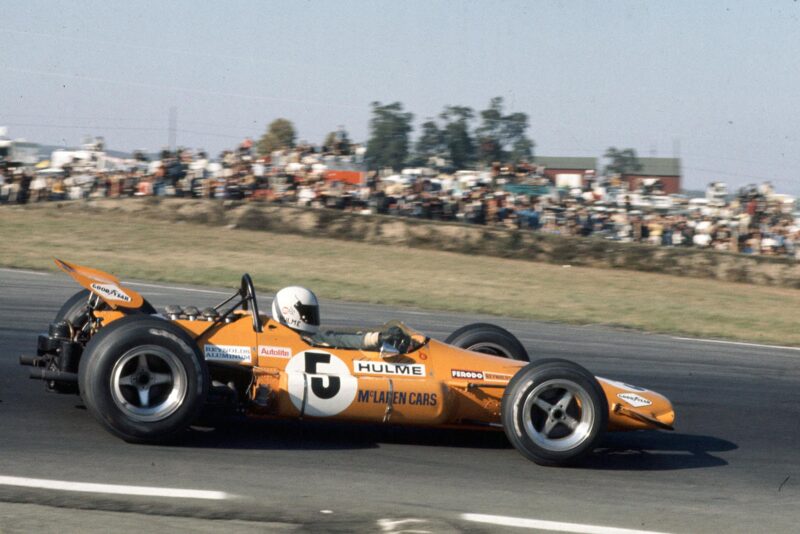
Denny Hulme put his McLaren 2nd on the grid next to pole-sitter Rindt
Motorsport Images
Practice was allocated for Friday and Saturday afternoons with a four-hour session on each day. The Friday session was nearly washed out and as far as times were concerned had absolutely no bearing on the grid whatsoever. It rained all day, some of the time just drizzling, but at other times it was quite heavy.
Added to this, a mist hung over the circuit, but visibility was certainly not so bad as it was during the German GP last year. Hulme and Lovely simply decided that it wasn’t worth practising while—though Eaton seemed keen enough—BRM Team Manager Tim Parnell decided against the youngster having his Formula One initiation in these conditions.
Dunlop produced a new rain tyre complete with “aquajets” as used on their SP Sport road tyres, a reversal from the usual format of road-going equipment being developed from the race track. These new tyres were used to good effect by the Matras, the BRMs and Courage. But eyes were on the two four-wheel-drive cars present, for Stewart decided to try the Matra MS 84 while Andretti was in the Lotus 63, so two of the top drivers were out trying the cars in the conditions under which they are expected to excel.
The results were to say the least rather disappointing. Stewart was over two seconds a lap quicker in his two-wheel-drive car after he had divided his time equally between the two cars, while Andretti was likewise two seconds a lap slower than his team-mates in the conventional cars and was far from enthusiastic about the handling.
Meanwhile, the pace was being set by Brabham, who finished up the fastest of the day at 1min 13.8sec which indicated that the wet track was slowing the cars about nine seconds. Beltoise, who concentrated on the conventional Matra, showed a considerable turn of speed to finish up second fastest ahead of Brabham’s team-mate Ickx. Stewart finished up fourth fastest in his regular Matra, just ahead of Courage with McLaren sixth.
Stewart did record the seventh fastest time overall with the four-wheel-drive effort, possibly more because of his great skill than anything else. The Lotus team were not having a happy time on their Firestone tyres, while the best Andretti could do was thirteenth fastest.
Surtees tried both his BRMs, but the new car suffered from stiff steering quite early on and though this was repaired for later in the session he continued to concentrate on the older car as this seemed to be going rather better than usual. The engines had been modified to the tune of a larger oil filtering system since Canada, but still seem to suffer from a very narrow power band compared with Cosworth V8s.
Before the practice session was over most people had got thoroughly wet and miserable and started to drift back to the cover of the “Tech Building”, but Courage practised on to the very end, for much of the last half hour being the only car on the track. The evening saw several engine changes but they were all more in the order of routine maintenance than because of mechanical damage.
On Saturday morning the sky had cleared but there was a very definite chill about the air which encouraged work rather than standing about. All 18 cars were practising this time and four hours later no less than half the field had lapped within half a second of the fastest man. There was rather more incentive insofar as there was an extra $1,000 at stake.
Siffert was the first to start getting under the old Formula One record of 1min 5.22sec, while Stewart, who usually makes the running, soon found out that he had calculated his gear ratios incorrectly. These were altered and Stewart then returned after about an hour and immediately became the man to beat. The two main pretenders to his title as top Formula One driver of the present time, lckx and Rindt, were both in trouble.
“Ickx’s wing broke away on the fastest part of the circuit and he had a very hair-raising spin off the course”
Ickx’s wing broke away on the fastest part of the circuit and he had a very hair-raising spin off the course which damaged the exhaust and the rear suspension. Only a lap later a piece flew out of Brabham’s clutch, so both the Brabham team cars were being worked on for most of the rest of the session, although both finally got mobile again.
Rindt’s problems were various, first it was a mis-firing engine and then an overheating tyre. There was only half an hour left when he started to get down to some really fast laps and at that time Hulme had just put in a quick one to head the list. Rindt showed all the skill he had displayed at Silverstone and bettered this time on several occasions.
Stewart was rather caught out doing a test with full fuel tanks, but the Tyrell team pumped most of the petrol out and in the last five minutes he tried to reclaim pole position. He got very close and reckoned another couple of laps would have done it, but it was too late.
So it was Rindt on pole with 1min 3.62sec, followed by Hulme at 1 min. 3.65 sec. and Stewart at 1min 3.77sec. The next eight cars were separated by only a second so a close race was obviously on the cards. Andretti was well down the list and would have liked to have tried a Lotus 49B.
Eaton was the slowest although he was not given very much of a chance as though the BRM team at Watkins Glen had no lower than four cars and six engines, only three sets of the rather complicated exhaust systems which the engines use were available.
Race
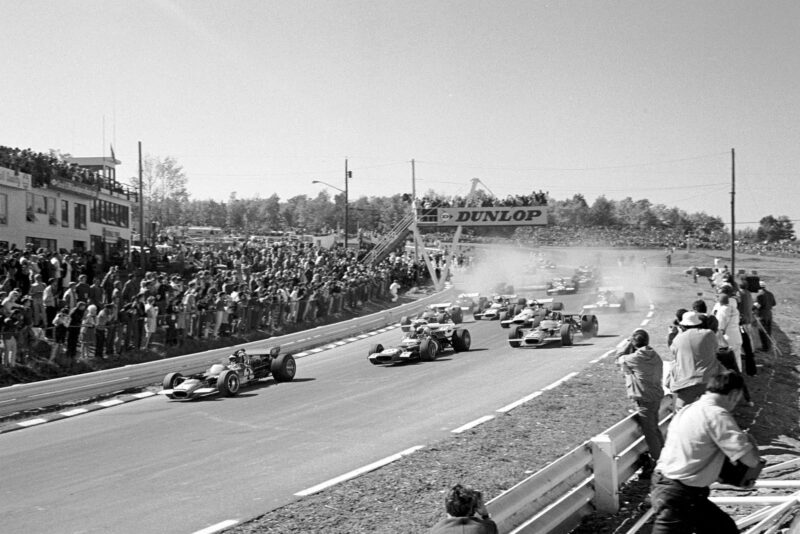
Rindt takes the lead upon starting
Motorsport Images
By Sunday morning the crowd had grown to over 100,000 and with only 2.3 miles of trackside, this meant that every vantage point was packed to overflowing. The cars were given three warm-up laps and for the McLaren team, usually so well prepared, it was disaster. McLaren’s car never came round at all, for a piston collapsed inside the engine and he walked back to the pits while Hulme somehow bent his gear linkage and mechanics worked frantically to repair it.
Surtees had a fuel relief valve changed on his BRM and Moser’s Brabham blew some of its water out and proved to be difficult to top up.
When the starter did his annual leap in the air it was almost twenty minutes late. Rindt surged into the lead while Hulme struggled with his gearbox and Stewart and Hill swept by in pursuit of the Austrian driver.
“Rindt was trying everything he knew to break away from the field”
As the cars disappeared out of sight of the pits that was the order, but further down the field Andretti suddenly went round sideways and came to a halt. He was soon under way again but no one seemed to know who he had bounced off. At the end of the first lap it was Rindt holding his lead from Stewart, Hill, Siffert, Beltoise, Courage, Ickx, Surtees, Hulme, Rodriguez, Brabham, Oliver, Servos-Gavin, Lovely, Eaton, Moser and, at the back, Andretti.
Rindt was trying everything he knew to break away from the field and in fact by the end of the third lap an appreciable gap had opened up excepting the important fact that Stewart was only feet behind. Just before the start Stewart had told Ken Tyrell that he thought that his engine was a little flat, possibly because of a broken valve spring, but he was lapping as fast as he had in practice with full tanks.
As was the case at Silverstone, these two went out ahead and the rest of the field settled down to their own private battle. Siffert had moved to the front of the group, but at the end of the lap he roared into the pits with the engine sounding very rough. The drive to the fuel metering unit had sheared and so he was the first retirement. Then Andretti arrived at the Lotus pit complaining of the handling of the car and it was immediately noticeable that the left-hand rear top wishbone had been bent by his first lap collision, so he retired.
By lap five it was Beltoise who came to lead the pursuing bunch, but rapidly losing sight of the tremendous battle between Rindt and Stewart. Line astern behind Beltoise were Courage, Hill, lckx, Surtees and Brabham. On lap six Hulme, who is having a rather unhappy Formula One season, made a pit stop for the gear linkage to be inspected. He was soon back in the pits again and the car was worked on for a long time before finally returning to the fray. At the back of the field there were three interesting little two-car battles between Oliver and Rodriguez, Servoz-Gavin and Moser and Lovely and Eaton, so there was plenty to hold the interest of the spectators although with Rindt and Stewart lapping in just over a minute what more could they want?
Most of the time Rindt seemed to have about three cars’ lengths lead but one had the impression that Stewart was perhaps biding his time a little and awaiting an opportunity, although already his car was puffing out a wisp of smoke occasionally. His team-mate was already in trouble, for Beltoise stopped at his pit to complain that he could not select fourth or fifth gear. He was sent back in the race to struggle on best he could and this he did until the engine expired many laps later under the strain.
Stewart’s shadowing of Rindt scored on lap 12 when the Austrian made a slight error and the Matra driver lost no opportunity in slipping by. Rindt had only lost a fraction and he was right on the tail of the Matra. The next nine laps were possibly the most exciting of all as the hungry Austrian, desperately wanting his first Grand Prix win, tried his utmost to re-pass the World Champion designate.
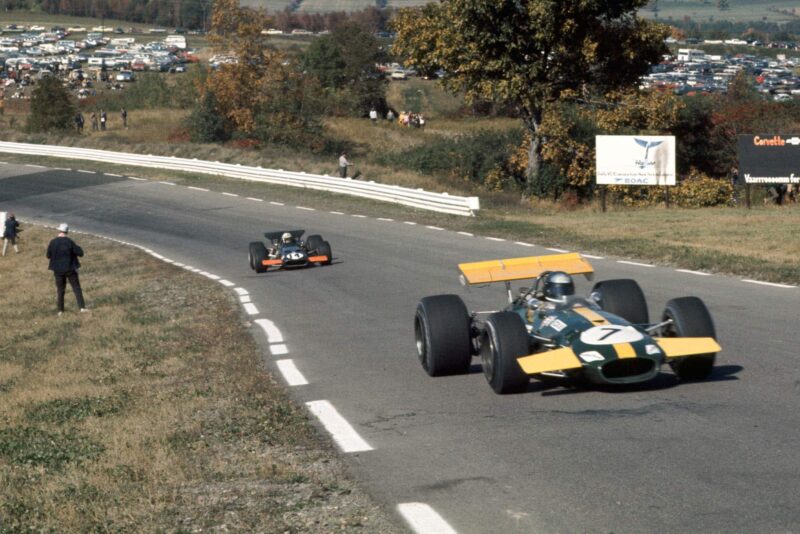
Jacky Ickx, seen here leading BRM’s Jackie Oliver, retired with an engine failure
Motorsport Images
The chance came on lap 21 and Rindt dived through on the inside of Stewart as they took the fast right-hand downhill sweep after the pits. Already the rest of the field were almost half a lap behind after only 22 of the 108 laps, for on this day Rindt and Stewart were in a different class from the rest of the field.
Even Ickx could not show his Canadian GP form and was desperately trying to snatch third position from Courage who was having none of it and was showing both the works Brabhams the way. The three Brabhams had broken away from the rest of the group with Surtees now sixth ahead of Hill. The pits had been busy again with Servoz-Gavin coming in to have his gear selection sorted out and he lost 10 laps or so in the process while Oliver’s BRM drive was again short, for he retired when his engine seized on lap 24.
Rindt now seemed to be opening a gap over Stewart with three or four laps’ hard work but a gap of a second and a half was drastically reduced when he got held up lapping Rodriguez. Nevertheless, the Lotus driver soon made up what he had lost, and more, and by lap 30 the gap was two seconds and had widened five laps later to five seconds. But now the Scotsman was obviously in trouble, for the car was smoking quite heavily, and on lap 36 he pulled into the pits to report that the oil pressure was plunging to zero. A rear oil seal had ruptured and the engine had lost most of its lubricant, so Rindt was on his own.
His lead over the Courage, Brabham, Ickx battle was now 37sec, but he had been in a similar situation in the Spanish GP and the car had let him down, so he was keeping his fingers very much crossed; nevertheless, he was still drawing away from the others. Surtees was up to fifth place and the BRM sounded very sweet as it pulled away from Hill.
Rodriguez, who was trying some new softer compound Firestone tyres, had to make a pit stop because they were chunking badly, and this moved Moser up to seventh ahead of Eaton. Lovely had dropped out with that popular Lotus 49B complaint, a broken constant velocity joint on a rear drive shaft.
“Brabham tried all the tricks but Courage would have none of it”
As the race ran past half-distance Rindt seemed very content to keep the gap between him and the three Brabhams at around 45sec, which was at least a mile and a half of track. The Brabham duel got even more intense as the race continued, for Brabham, who had been content to let Ickx try to pass Courage, moved ahead himself to sort out the private car. Brabham tried all the tricks, such as rushing up the inside under late braking in an attempt to force Courage to move over, but Courage would have none of it and retaliated by occasionally dropping a wheel in the dirt and flinging up a stone or two at Brabham.
By three-quarter-distance Rindt’s car was still running perfectly and the gap was still just about three-quarters of a minute. Further down the field Surtees was about to be lapped by the three Brabhams; Rodriguez had made up considerable lost time and re-passed Moser, while Eaton’s engine had started to seize and he stopped. The next retirement was that of Ickx, for his engine suddenly lost power and he pulled the car well off the road, causing several people to think he had spun.
Although Courage and Brabham were continuing their battle at an unabated speed, Rindt had decided to ease because there was a lot of oil on the corner called the Loop. He was also a little worried about running low on fuel as he had done at Silverstone when in a strong position.
It was on this oil that Hill spun with about 20 laps to go and he left the track and was unable to re-start the car on the button. So he got out of the cockpit to manoeuvre the car and was able to re-start, but what he was not able to do was re-fasten his safety belts for they are so made that to do them up properly one needs assistance. But he possibly picked up a stone in the tyre when he slid off, for a couple of laps later he came by the pits pointing back at a noticeably spongy tyre. No doubt he was hoping the Lotus pit would have another ready for him when he came in next lap.
Unfortunately he never made it, for the car suddenly shot off sideways on the straight before the Loop. It hit a mound of earth and overturned, losing much of its suspension as it went. Hill was thrown out and his legs received a tremendous battering as he was thrown out. The popular London driver was taken to hospital with both his knees badly damaged and he may be out of racing for many months.
Soon after this sad accident Courage found himself without his persistent shadow, for Brabham had rushed into the pits complaining of fuel starvation. There was still five or six gallons in the tanks but the fuel system was just not picking it up, probably due to a faulty flap valve, so several more gallons were added. Brabham rejoined the race, but he had lost two laps and he was now just behind Surtees. In the closing stages he managed to pass the BRM, but had no hope of making up a complete lap on him to regain third place.
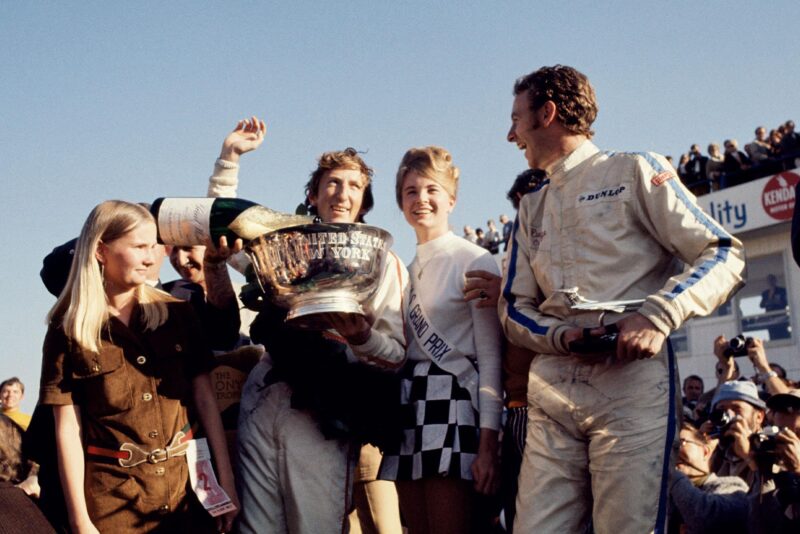
Rindt celebrates his debut win
Motorsport Images
So the closing stages came as rather an anti-climax, with Rindt reeling off the laps eventually to come home some three-quarters of a lap ahead of Courage. Surtees was two laps down in third place with the BRM, followed by Brabham, Rodriguez was fifth but a further five laps in arrears, while Moser scored his first point of the season despite being 10 laps behind the winner, having at one stage made a brief pit stop because of a loose oil pipe. Servoz-Gavin was still running at the finish, but he only completed 92 laps.
Rindt had finally achieved his ambition: it was bound to happen some time, for this was the sixth occasion this season that he had started from pole position. As he commented later, he was driving no better than usual, but for once everything had gone right. Courage, too, went up in the estimation of a lot of people following his fine drive, and the organisers awarded him a special “Man of the Meeting” prize of $5,000. One hundred thousand Americans went home satisfied that they had seen Grand Prix racing at its best.
